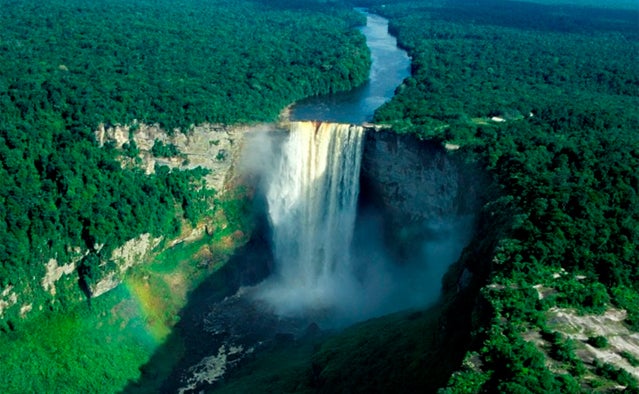
Kaieteur Falls, Guyana. Photo: Wilderness Explorers
Newsweek said last week that visiting Guyana should be on your Bucket List. Then USA Today said just about the same thing. We first sang Guyana's praises back in 2009.
Guyana is emerging as an ecotourism hot spot because it is English-speaking, politically stable, nearly completely covered in rainforest and boasts great birdwatching and fly-fishing. The number of tourists it hosts each year is (for now, anyway) minuscule compared to other tropical Latin American destinations.
But Guyana is rich in other resources, as well. Some of it in the form of oil resting under the Atlantic off the country's lush coastline. Guyana recently granted exploration rights to a Texas-based Anadarko Petroleum Corp., which will look for drilling sites. Exxon and a number of other oil companies are doing the same thing. Gold and timber are also being exploited, and not always legally. Domestic and foreign agribusiness interests are looking to greatly expand water-intensive rice farming as a cash crop along previously pristine waterways.
All of this puts Guyana in a precarious position. Will it continue to develop its path as a secluded haven for eco-minded tourists or will it open up to energy and mineral companies? The situation is especially vexxing because its mineral, forest and water resources are in the country's interior, where its indigenous population has been slowly building up a tourism foundation at Surama, Rewa, and Nappi Villages, as well as the Iwokrama Canopy Walkway.
“In Guyana's interior, there is no local industry with any scale, and most people farm or fish on a sustenance basis” says Michael McCrystal, a U.S.-based business consultant serving Guyana's hospitality industry. “Tourism is one of the few ways Amerindian villagers can earn cash other than resorting to mining, timber, or the exotic pet trade.”
Thus far, the Guyanese government has supported tourism as well as conservation through its Low Carbon Development Strategy (LCDS), which promotes sustainable resource development as an economic development tool. How far can those good intentions go when the outside interests, China among them, are constantly knocking at the government's door? On offer is not just a cut of the takings but infrastructure development, such as paving the dirt road that acts as the only trans-national thoroughway.
“China has been prominent on the scene in the last few years, making major investments in the country's first big hotel construction project, vehicle ferries, and a proposal to redevelop the international airport,” says McCrystal.
On the other hand, there are good arguments for Guyana to resist the entry of large, conventional resource extraction, says McCrystal, For one thing, there are plenty of examples of other small, resource-rich nations that took that path to the detriment of their native people, cultures and resources. Plus, he says, “Amerindian leaders recognize that direct and indirect employment resulting from service industries like tourism can not only protect the environment on their historical lands, but provide a way to elevate and preserve their culture and historical knowledge in ways that extractive industries cannot.”
—Mary Catherine O'Connor
@mcoc